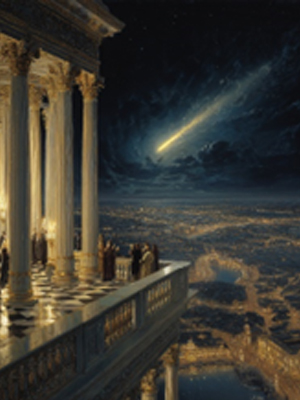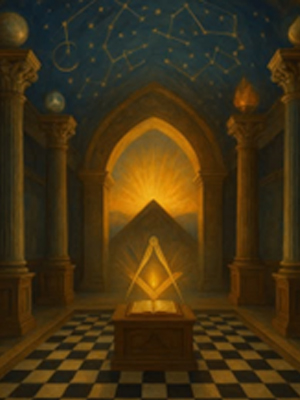Masonic Articles and Essays
Comets as Messengers in Enlightenment Freemasonry
Very Illus..... Bro... Pamela McDown 33°
Date Published:
10/15/2025
Once feared as omens of disaster, comets became symbols of enlightenment - bridging science, symbolism, and the divine order of the cosmos. What hidden light might such celestial wanderers still reveal to us today?
 There’s been a lot of conversation lately about 3I/ATLAS, the mysterious interstellar comet now making its way through our solar system. Whenever humanity looks to the celestial canopy, we instinctively search for meaning, whether in science, religion, or symbolism. And comets, perhaps more than any other celestial visitor, have carried that burden of mystery. Are they messengers of doom? Signs of transformation? Or invitations to think beyond ourselves?
There’s been a lot of conversation lately about 3I/ATLAS, the mysterious interstellar comet now making its way through our solar system. Whenever humanity looks to the celestial canopy, we instinctively search for meaning, whether in science, religion, or symbolism. And comets, perhaps more than any other celestial visitor, have carried that burden of mystery. Are they messengers of doom? Signs of transformation? Or invitations to think beyond ourselves?
Tracing the story of comets through history, and their surprising place in the symbolic heart of Enlightenment Freemasonry, reveals a shift from fear to wonder, from superstition to science, and of science blending into symbolism.
Halley’s Comet and the Enlightenment Shift
From ancient times, comets were fiery omens, blamed for plagues, wars, and the fall of kings. But in the 17th and 18th centuries, they became something new: lawful, predictable bodies. Isaac Newton’s Principia Mathematica (1687) showed that comets, like planets, obeyed the universal law of gravitation. His friend and disciple, Edmond Halley, analyzed centuries of records and predicted that the comet of 1682 would return in 1759. When it reappeared right on schedule, it was nothing less than a scientific triumph.
For the first time in European history, a comet’s blaze was no longer a harbinger of doom but proof of cosmic order. To Enlightenment Freemasons, this was more than science, it was a transformation of symbol. The Philosophical Transactions of the Royal Society carried lively debates about comets, while Grand Lodge officers often attended public astronomy lectures. The heavens themselves had become a classroom, and comets were part of the lesson.
Thus, for the Brethren of that time, the comet was more than a curiosity. It became a metaphor for transformation, illumination, and revelation. Like a streak of fire across the night sky, it captured both fear and wonder. Truth, it suggested, sometimes arrives not gradually like the rising sun, but suddenly, flaring, dazzling, and impossible to ignore.
Desaguliers and the Blazing Star
No one carried this vision into Masonry more directly than Jean-Théophile Desaguliers (1683–1744), a French Huguenot refugee, Anglican clergyman, Newton’s protégé, and Grand Master of the Premier Grand Lodge of England. Both scientist and Mason, Desaguliers helped codify rituals and lectures, embedding Enlightenment ideals within the Craft.
For him, comets were not terrifying meteors but evidence of divine order. In verse he wrote:
“Comets (no longer Meteors to be fear’d,
As threatening Vengeance with their Tail or Beard)
By telescopes were lasting Bodies prov’d,
Like planets, in revolving Orbits mov’d.”
According to some Masonic researchers, the Blazing Star’s appearance in Lodge furnishings during this era was credited to Desaguliers and represented a comet. Its sudden light mirrored Masonry’s teaching: that even the most unpredictable moments of life are still governed by law and can reveal higher truths. Here the comet was no longer chaos but illumination, a symbol that divine law and cosmic beauty were united.
Yet symbolism varied. Across the Channel, French Masonry usually interpreted the Étoile Flamboyante, the Blazing Star, as the Star of Bethlehem, a beacon of Christian mysticism rather than Newtonian science. What matters is not settling on one definition, but recognizing that the Blazing Star, whether comet, or Bethlehem’s light, always points to guidance, inspiration, and transformation.
If comets once symbolized terror but came to represent enlightenment, how did Newton’s and Halley’s discoveries affect other symbolism in Masonic teachings?
The Lodge as a Microcosm
Beyond the comet, Enlightenment Masons also placed the entire firmament within the Lodge, described in cosmic terms: extending “from East to West, between North and South, from the center of the Earth to the highest heavens.” The “starry-decked canopy” stretched above the initiate, reminding him that his labors on earth echoed the harmony of the heavens. The movements of the sun and moon marked the hours of labor and refreshment; the pillars of East, West, and South echoed the rising, meridian, and setting sun.
 Masonic tools were not only working instruments of the builder but also moral instruments of the initiate, guiding him to align his life with the Great Architect of the Universe. The compasses, used to circumscribe circles, recall the arcs of the heavens. The plumb line reflects the cosmic axis connecting zenith and nadir. Even the Mosaic Pavement, with its pattern of black and white, evokes the alternation of night and day, light and darkness, that governs the rhythms of the cosmos. Squaring the Lodge echoes the four cardinal points by which ancient astronomers and navigators oriented themselves.
Masonic tools were not only working instruments of the builder but also moral instruments of the initiate, guiding him to align his life with the Great Architect of the Universe. The compasses, used to circumscribe circles, recall the arcs of the heavens. The plumb line reflects the cosmic axis connecting zenith and nadir. Even the Mosaic Pavement, with its pattern of black and white, evokes the alternation of night and day, light and darkness, that governs the rhythms of the cosmos. Squaring the Lodge echoes the four cardinal points by which ancient astronomers and navigators oriented themselves.
Astronomy was more than metaphor. The Seven Liberal Arts and Sciences, central to Masonic learning, culminated in astronomy as the “sublime science.” To study the heavens was to study order, law, and proportion. And yet, within this order, comets carried the symbolic lesson that even within law there is surprise, that divine revelation can break through the familiar patterns. Just as the telescope revealed hidden stars and galaxies, initiation was meant to reveal hidden truths within the soul.
Thus, the story of astronomy during the Enlightenment era gives us a compelling historical lens on Freemasonry. How, then, do historical readings deepen the meaning of this symbol in our own work today?
Lessons from the Comets
Today, as astronomers track 3I/ATLAS, only the third known interstellar comet, we find ourselves in a position not unlike our Enlightenment forebears. Unlike Halley’s Comet, whose return can be predicted with precision, 3I/ATLAS is not bound to the Sun at all. It is a cosmic traveler from another star system, a true wanderer that will sweep through our skies once and then vanish forever into the abyss. Even more striking, its closest approach will occur at the Winter Solstice of 2025, a turning point in the human calendar already filled with symbolism: the longest night giving way to the gradual return of light.
For Masons, the symbolic lesson is profound. Halley’s Comet reminds us of recurrence, of the steady cycles of truth that reappear to guide each generation. But 3I/ATLAS is different. It teaches that some insights do not return; they arrive suddenly, like a flash of brilliance, and demand that we seize them before they pass. Such revelations are fleeting but transformative, urging us to be watchful, alert, and ready to recognize light when it breaks into our lives.
Comets also show that mystery is not the enemy of law but its companion. Newton demonstrated that even their erratic paths obey the harmony of the cosmos, yet their sudden appearance still provokes awe. In this way, comets embody the paradox at the heart of Freemasonry: that the universe is both rational and mysterious, lawful and wondrous.
Their symbolic arc, from dreaded omens to scientific marvels to emblems of illumination, reminds us that light comes in many forms. Stars guide us with constancy; comets awaken us with surprise. Both are needed for growth. Perhaps this is the comet’s enduring gift: it interrupts routine with a blaze and a question—is there more to know, more to see?
“The All-seeing Eye, whom the SUN, MOON, and STARS obey, and under whose watchful care, even COMETS perform their stupendous revolutions, pervades the inmost recesses of the human HEART, and will reward us according to our merits.”
— Sir Robert Moray
More Masonic Articles
Explore articles and essays written by Freemasons about Freemasonry.
Read More
Membership
Interested in becoming a member of the worlds oldest Fraternal organization?
Read More